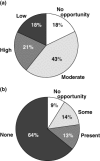Putting informed and shared decision making into practice
- PMID: 17083559
- PMCID: PMC5060372
- DOI: 10.1111/j.1369-7625.2006.00404.x
Putting informed and shared decision making into practice
Abstract
Objective: To investigate the practice, experiences and views of motivated and trained family physicians as they attempt to implement informed and shared decision making (ISDM) in routine practice and to identify and understand the barriers they encounter.
Background: Patient involvement in decision making about their health care has been the focus of much academic activity. Although significant conceptual and experimental work has been done, ISDM rarely occurs. Physician attitudes and lack of training are identified barriers.
Design: Qualitative analysis of transcripts of consultations and key informant group interviews.
Settings and participants: Six family physicians received training in the ISDM competencies. Audiotapes of office consultations were made before and after training. Transcripts of consultations were examined to identify behavioural markers associated with each competency and the range of expression of the competencies. The physicians attended group interviews at the end of the study to explore experiences of ISDM.
Results: The physicians liked the ISDM model and thought that they should put it into practice. Evidence from transcripts indicated they were able to elicit concerns, ideas and expectations (although not about management) and agree an action plan. They did not elicit preferences for role or information. They sometimes offered choices. They had difficulty achieving full expression of any of the competencies and integrating ISDM into their script for the medical interview. The study also identified a variety of competency-specific barriers.
Conclusion: A major barrier to the practice of ISDM by motivated physicians appears to be the need to change well-established patterns of communication with patients.
Figures
Similar articles
-
Perspectives of family physician educators on shared decision making in preventive health care: A Qualitative Descriptive Inquiry.Patient Educ Couns. 2025 May;134:108681. doi: 10.1016/j.pec.2025.108681. Epub 2025 Jan 25. Patient Educ Couns. 2025. PMID: 39889418
-
A qualitative systematic review of internal and external influences on shared decision-making in all health care settings.JBI Libr Syst Rev. 2012;10(58):4633-4646. doi: 10.11124/jbisrir-2012-432. JBI Libr Syst Rev. 2012. PMID: 27820528
-
Evaluation of the quality of patient information to support informed shared decision-making.Health Expect. 2001 Dec;4(4):235-42. doi: 10.1046/j.1369-6513.2001.00144.x. Health Expect. 2001. PMID: 11703497 Free PMC article.
-
Implementation of shared decision-making in oncology: development and pilot study of a nurse-led decision-coaching programme for women with ductal carcinoma in situ.BMC Med Inform Decis Mak. 2017 Dec 6;17(1):160. doi: 10.1186/s12911-017-0548-8. BMC Med Inform Decis Mak. 2017. PMID: 29212475 Free PMC article.
-
Informed shared decision making: An exploratory study in pharmacy.Pharm Pract (Granada). 2008 Apr;6(2):57-67. doi: 10.4321/s1886-36552008000200001. Epub 2008 Jun 17. Pharm Pract (Granada). 2008. PMID: 25157282 Free PMC article.
Cited by
-
About time: how time influences and facilitates patient autonomy in the clinical encounter.Monash Bioeth Rev. 2018 Dec;36(1-4):68-85. doi: 10.1007/s40592-018-0089-7. Monash Bioeth Rev. 2018. PMID: 30617789 Free PMC article.
-
SDM Training Modules for Health and Social Care Professionals in Israel.Front Psychiatry. 2021 Sep 27;12:679036. doi: 10.3389/fpsyt.2021.679036. eCollection 2021. Front Psychiatry. 2021. PMID: 34646172 Free PMC article.
-
The role of medical schools in promoting social accountability through shared decision-making.Isr J Health Policy Res. 2014 Jul 22;3:26. doi: 10.1186/2045-4015-3-26. eCollection 2014. Isr J Health Policy Res. 2014. PMID: 25075274 Free PMC article.
-
Teaching Shared Decision Making to Family Medicine Residents: A Descriptive Study of a Web-Based Tutorial.JMIR Med Educ. 2016 Dec 19;2(2):e17. doi: 10.2196/mededu.6442. JMIR Med Educ. 2016. PMID: 27993760 Free PMC article.
-
"It wasn't as bad as I thought it would be": a qualitative study of early stage non-small cell lung cancer patients after treatment.BMC Res Notes. 2017 Nov 29;10(1):642. doi: 10.1186/s13104-017-2956-3. BMC Res Notes. 2017. PMID: 29187237 Free PMC article.
References
-
- Coulter A. The Autonomous Patient. Ending Paternalism in Medical Care. London: Nuffield Trust, 2002.
-
- Fenwick P, Beran RG. Informed consent – should Bolam be rejected? Medical Law, 1996; 16: 215–223. - PubMed
-
- Department of Health . Patient and Public Involvement in the New NHS. London: Department of Health, 1999.
-
- General Medical Council . Good Medical Practice. London: GMC, 2001.
-
- Edwards A, Evans R, Elwyn G. Manufactured but not imported: new directions for research in shared decision making support and skills. Patient Education and Counseling, 2003; 50: 33–38. - PubMed
Publication types
MeSH terms
LinkOut - more resources
Full Text Sources
Medical


